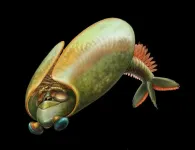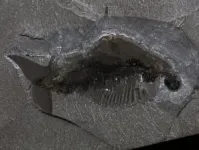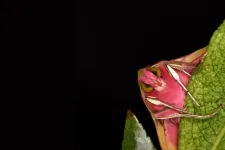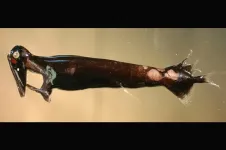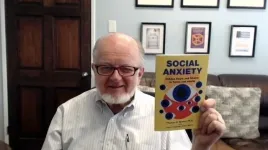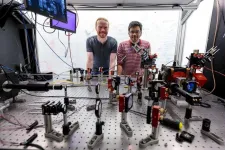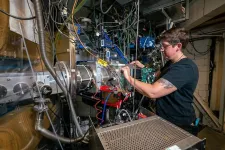(Press-News.org) A new study, led by palaeontologists at the Royal Ontario Museum (ROM) is helping resolve the evolution and ecology of Odaraia, a taco-shaped marine animal that lived during the Cambrian period. Fossils collected by ROM reveal Odaraia had mandibles. Palaeontologists are finally able to place it as belonging to the mandibulates, ending its long enigmatic classification among the arthropods since it was first discovered in the Burgess Shale over 100 years ago and revealing more about early evolution and diversification. The study The Cambrian Odaraia alata and the colonization of nektonic suspension-feeding niches by early mandibulates was published in the journal Proceedings B.
The study authors were able to identify a pair of large appendages with grasping jagged edges near its mouth, clearly indicative of mandibles which are one of the key and distinctive features of the mandibulate group of animals. This suggests that Odaraia was one of the earliest known members of this group. The researchers made another stunning discovery, a detailed analysis of its more than 30 pairs of legs, found an intricate system of small and large spines. According to the authors, these spines could intertwine, capturing smaller prey as though a fishing net, suggesting how some of these first mandibulates left the sea floor and explored the water column, setting the seeds for their future ecological success.
“The head shield of Odaraia envelops practically half of its body including its legs, almost as if it were encased in a tube. Previous researchers had suggested this shape would have allowed Odaraia to gather its prey, but the capturing mechanism had eluded us, until now,” says Alejandro Izquierdo-López, lead author, who was based at ROM during this work as a PhD student at the University of Toronto. “Odaraia had been beautifully described in the 1980s, but given the limited number of fossils at that time and its bizarre shape, two important questions had remained unanswered: is it really a mandibulate? And what was it feeding on?”
At almost 20 cm in size, the authors explain that early mandibulates like Odaraia were part of a community of large animals that could have been able to migrate from the marine bottom-dwelling ecosystems characteristic of the Cambrian period to the upper layers of the water column. These types of communities could have enriched the water column and facilitated a transition towards more complex ecosystems.
Cambrian fossils record the major divergence of animal groups originating over 500 million years ago. This period saw the evolution of innumerable innovations, such as eyes, legs or shells, and the first diversification of many animal groups, including the mandibulates, one of the major groups of arthropods (animals with jointed limbs).
Mandibulates are an example of evolutionary success, representing over half of all current species on Earth. Today, mandibulates are everywhere: from sea-dwelling crabs to centipedes lurking in the undergrowth or bees flying across meadows, but their beginnings were more humble. During the Cambrian period, the first mandibulates were marine animals, most bearing distinct head shields or carapaces.
“The Burgess Shale has been a treasure trove of paleontological information,” says Jean-Bernard Caron, Richard Ivey Curator at the Royal Ontario Museum, and co-author of the study. “Thanks to the work we have been doing at the ROM on amazing fossil animals such as Tokummia and Waptia, we already know a substantial amount about the early evolution of mandibulates. However, some other species had remained quite enigmatic, like Odaraia.”
The Royal Ontario Museum holds the largest collections of Cambrian fossils from the world-renowned Burgess Shale of British Columbia. Burgess Shale fossils are exceptional, as they preserve structures, animals and ecosystems that under normal conditions would have decayed and completely disappeared from the fossil record. Mandibulates, though, are generally rare in the fossil record. Most fossils preserve only the hard parts of animals, such as skeletons or the mineralized cuticles of the well-known trilobites, structures that mandibulates lack.
For over forty years Odaraia has been one of the most iconic animals of the Burgess Shale, with its distinctive taco-shaped carapace, its large head and eyes, and a tail that resembles a submarine's keel. The public can view specimens of Odaraia on display at the Willner Madge Gallery, Dawn of Life at the Royal Ontario Museum.
END
Taco-shaped arthropod from Royal Ontario Museum’s Burgess Shale fossils gives new insights into the history of the first mandibulates
Exceptional fossils show how mandibulates were trapping prey in marine ecosystems 500 million years ago
2024-07-24
ELSE PRESS RELEASES FROM THIS DATE:
Butterflies accumulate enough static electricity to attract pollen without contact, new research finds
2024-07-24
Butterflies and moths collect so much static electricity whilst in flight, that pollen grains from flowers can be pulled by static electricity across air gaps of several millimetres or centimetres.
The finding, published today in the Journal of the Royal Society Interface, suggests that this likely increases their efficiency and effectiveness as pollinators.
The University of Bristol team also observed that the amount of static electricity carried by butterflies and moths varies between different species, and that these variations correlate with differences in their ecology, such as whether they visit flowers, are ...
Eyes for Love: Searching for light and a mate in the deep, dark sea, male dragonfishes grow larger eyes than the females they seek
2024-07-24
Chestnut Hill, Mass (07/24/2024) – A small but ferocious predator, the male dragonfish will apparently do anything for love. Or at least to find a mate.
A new study by researchers at Boston College found the eyes of the male dragonfish grow larger for mate-seeking purposes, making the dragonfish an anomaly in vertebrate evolution, the team reported today in the Royal Society journal Biology Letters.
Like many creatures that inhabit the dark depths of the sea, dragonfishes survive thanks to numerous ...
PNNL scientists tap nation’s fastest computers to explore critical science questions
2024-07-24
RICHLAND, Wash.—Researchers at the Department of Energy’s Pacific Northwest National Laboratory have been awarded more than 3 million node hours on the nation’s most powerful computers to explore questions around pathogens, climate and energy-efficient microelectronics.
Access to the nation’s supercomputers, granted to Margaret Cheung, Daniel Mejia Rodriguez and Po-Lun Ma, is a coveted prize among scientists. The node hours represent an investment of several million dollars in computing time awarded to PNNL scientists to explore important science questions.
The awards are among 44 projects awarded through ...
Peri-operative care of transgender and gender-diverse individuals: new guidance for clinicians and departments published
2024-07-24
New guidance on peri-operative care of transgender and gender-diverse individuals is today published in Anaesthesia (the journal of the Association of Anaesthetists) to guide best practice to ensure the safety and dignity of transgender and gender-diverse people in the peri-operative period. The guidance has been produced by a working group of experts including Dr Stuart Edwardson, Royal Infirmary of Edinburgh, Edinburgh, UK, and Dr Luke Flower, Victor Philip Dahdaleh Heart and Lung Research Institute, Cambridge, UK, and colleagues.
The number of people openly identifying ...
Clinical psychologist’s book addresses largely ignored problem: social anxiety
2024-07-23
RIVERISDE, Calif. -- We all have some social anxiety. The nervousness we might feel before giving a speech is one example. Some people, however, have more social anxiety than others, and limit their social engagement due to excessive chronic fears of being embarrassed or humiliated. Although such social anxiety is common in both adolescents and adults, it is rarely diagnosed and treated.
In a new book titled “Social Anxiety: Hidden Fears and Shame in Teens and Adults,” Thomas E. Brown, a clinical professor of psychiatry and neuroscience in the University of California, Riverside's School of Medicine , explains ...
Researchers leveraging AI to train (robotic) dogs to respond to their masters
2024-07-23
An international collaboration seeks to innovate the future of how a mechanical man’s best friend interacts with its owner, using a combination of AI and edge computing called edge intelligence.
The project is sponsored through a one-year seed grant from the Institute for Future Technologies (IFT), a partnership between New Jersey Institute of Technology (NJIT) and Ben-Gurion University of the Negev (BGU).
Assistant Professor Kasthuri Jayarajah in NJIT’s Ying Wu College of Computing is researching how to design a socially assistive model ...
Drawing water from dry air
2024-07-23
Earth’s atmosphere holds an ocean of water, enough liquid to fill Utah’s Great Salt Lake 800 times.
Extracting some of that moisture is seen as a potential way to provide clean drinking water to billions of people globally who face chronic shortages.
Existing technologies for atmospheric water harvesting (AWH) are saddled with numerous downsides associated with size, cost and efficiency. But new research from University of Utah engineering researchers has yielded insights that could improve efficiencies and bring the world one step closer to tapping the air as a culinary water source in arid places.
The study unveils the first-of-its-kind ...
Combining trapped atoms and photonics for new quantum devices
2024-07-23
Quantum information systems offer faster, more powerful computing methods than standard computers to help solve many of the world’s toughest problems. Yet fulfilling this ultimate promise will require bigger and more interconnected quantum computers than scientists have yet built. Scaling quantum systems up to larger sizes, and connecting multiple systems, has proved challenging.
Now, researchers at the University of Chicago’s Pritzker School of Molecular Engineering (PME) have discovered how to combine two powerful technologies—trapped atom arrays and photonic devices—to ...
A new way to make element 116 opens the door to heavier atoms
2024-07-23
Scientists at the Department of Energy’s Lawrence Berkeley National Laboratory (Berkeley Lab) are credited in the discovery of 16 of the 118 known elements. Now they’ve completed the crucial first step to potentially create yet another: element 120.
Today, an international team of researchers led by Berkeley Lab’s Heavy Element Group announced that they have made known superheavy element 116 using a titanium beam, a breakthrough that is a key stepping stone towards making element 120. The result was presented today at the Nuclear Structure 2024 conference; the science paper will be posted on the online repository ...
New genetic tool could identify drug targets for diseases associated with metabolic dysfunction
2024-07-23
There’s a glaring gap in our knowledge of cell metabolism: in many cases, we still don’t know exactly how nutrients are transported into the cell. Without that understanding, it’s extremely difficult, if not impossible, to develop treatments for the many diseases linked to the protein transporters that drive metabolism. Now, a new study in Nature Genetics presents a tool to map these metabolic gene functions more precisely. The platform, dubbed GeneMAP, has already identified one key gene-metabolite association at the heart of mitochondrial metabolism.
GeneMAP was developed in the laboratory of Kivanç Birsoy, ...
LAST 30 PRESS RELEASES:
Post-stroke injection protects the brain in preclinical study
Cardiovascular risk score predicts multiple eye diseases
Health: estimated one in ten British adults used or interested in GLP-1 medications for weight loss
Exercise to treat depression yields similar results to therapy
Whooping cough vaccination for pregnant women strengthens babies’ immune system
Dramatic decline in new cases of orphanhood in Uganda driven by HIV treatment and prevention programs
Stopping weight loss drugs linked to weight regain and reversal of heart health markers
Higher intake of food preservatives linked to increased cancer risk
Mass General Brigham–developed cholera vaccine completes phase 1 trial
First experimental validation of a “150-year-old chemical common sense” direct visualization of the molecular structural changes in the ultrafast anthracene [4+4] photocycloaddition reaction
Lack of support for people on weight loss drugs leaves them vulnerable to nutritional deficiencies, say experts
Dogs’ dinners can have greater climate impact than owners’
Are you ready to swap salmon for sprats and sardines?
1.6 million UK adults used weight loss drugs in past year
American College of Cardiology comments on new dietary guidelines for Americans
American Society of Gene & Cell Therapy and Orphan Therapeutics Accelerator partner to advance and commercialize promising rare disease treatments
One in 14 patients having day case surgery have new or worse chronic pain 3 months after their operation
New study highlights link between eviction rates and gun violence
Heatwaves heat up soil but not toxin levels in rice, study finds
Digital modeling reveals where construction carbon emissions really come from
Turning farm waste into water filters
New study shows how the spleen helps the immune system accept a transplant
New Mayo Clinic study advances personalized prostate cancer education with an EHR-integrated AI agent
Researchers identify novel therapeutic target to improve recovery after nerve injury
Microbes in breast milk help populate infant gut microbiomes
Reprogramming immunity to rewrite the story of Type 1 diabetes
New tool narrows the search for ideal material structures
Artificial saliva containing sugarcane protein helps protect the teeth of patients with head and neck cancer
Understanding the role of linear ubiquitination in T-tubule biogenesis
Researchers identify urban atmosphere as primary reservoir of microplastics
[Press-News.org] Taco-shaped arthropod from Royal Ontario Museum’s Burgess Shale fossils gives new insights into the history of the first mandibulatesExceptional fossils show how mandibulates were trapping prey in marine ecosystems 500 million years ago
